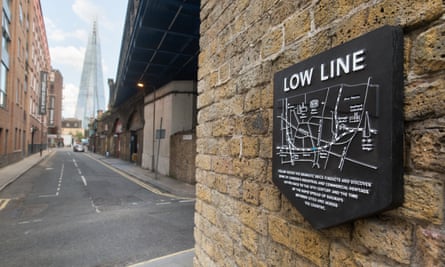I can hear a constant rattle from the railway line above as I huddle under Bankside’s railway arches to get cover from the rain, but with my headphones on, it is the sound of a bassoon that provides the main, moody soundtrack to these medieval London streets.
The song is Ewer Street by Thomas Stone, an electroacoustic composer and musician from London. He created the track specifically for the street I’m standing on, and it’s only available to listen to within a 100-metre radius of where I am: it was designed for listening here and only here, where the clanking railway lines and the distant conversations of passersby add another layer to the music.
“Cities are these amazing possibilities to put two things together: music and architecture. The city is a playground, a backdrop for music,” says Nick Luscombe, presenter of BBC Radio 3’s Late Junction and founder of Musicity, a platform that invites musicians to compose tracks in response to buildings and locations in cities. Musicity uses geo-tagging to link the tracks to the locations that inspired it. Once you’re standing in that location, you log on to the site and listen to the song. “It adds another layer to the richness of the neighbourhood,” he says.
Music has always been inextricably linked with cities, from the artists who grew up there and were inspired by experiences or spaces to the sounds and genres that spawned from the streets or buildings. Musicity builds on this idea, by making music and sound art part of the architecture of the city itself.
Luscombe says: “A hundred years down the road, the railway will still be here. Half of the buildings might not be, but the music will still be there in those locations. The tracks will be there forever now.”
Musicity was commissioned by the business improvement district Better Bankside, along with Team London Bridge and Blue Bermondsey, to create 15 pieces of music as a soundtrack to the Low Line, a new walking route along the Victorian rail viaducts spanning Bankside, London Bridge and Bermondsey.

Using smartphones, people follow the map on the Musicity website and click on the songs connected to points across the route.
The idea is to use music as a way to open up this walk and the hidden areas underneath the arches to local communities and visitors. It gives people a reason to go to these backstreets, often overlooked by the nearby South Bank and prominent cultural institutions such as Tate Britain and the Globe theatre.
“It provides a way for people who live and work along the line to experience the neighbourhood in a different way that’s specific and rooted in an area,” says Valerie Beirne, Bankside’s urban forest manager. “We’re creating a connection to the streets.”
The Low Line was conceived by a local resident, the former architect David Stephens, in 2012. Inspired by New York’s High Line, London’s version follows the centuries-old rail arches spanning this area south of the river. The Low Line is part of Bankside’s regeneration to open up the mostly car-free base of the Victorian viaducts, and bring commercial development, whether that be cultural or retail, to the unused arches.
Now the Low Line has a soundtrack to go with it. We turn a corner and follow the base of the railway line to Wardens Grove, the third stop along the route, tucked away behind the Metal Box Factory, just off Southwark Street.

This song, Wardens Grove, is by singer and composer Szjerdene, who grew up in north-east London and lives in Amsterdam. “I love London. I was born and raised here but every time I come back it’s a harsh reminder of the energy of London, its hustle mentality of keeping your head down,” she tells me later over the phone.
“Generally, it’s a gritty city and you have to have substance to survive here. All of this was going into the song – my feelings towards the city itself.”
Wardens Grove is a beautifully melancholic track. I listen standing by the viaduct in this open space looking on to the back of the former factory, redeveloped to house studios and offices, as the Shard pokes out in the distance.
“I wanted the sounds to reflect the constantly changing face. You only listen to it at that location, so it brings that connectivity,” she says.
“Every time I visit London there’s something new to see but [it] still has that iron heart, a pulse that beats through which has the same ethos and feeling at its depth. I wanted the sounds to reflect this.”
She used metallic, industrial sounds, harking back to this area’s former life as a tin box factory. Field recordings of conversations enhance the real-life voices of passersby.
It’s a fitting soundtrack but beyond this, just taking two and a half minutes to stop and listen is captivating in itself. You notice parts of the city you would not normally see; something beautiful in how brickwork is reflected in a puddle, or even just discovering a new cafe under the arches.
“It’s important that people get out. They can do two things at once: get tracks, enjoy different locations and get inspired by the city,” says Luscombe. “Music is the most immediate artform there is. We have such a connection to sound. The idea of having headphones where you still hear some background noise is even more valuable. You feel you’re in several different worlds.”
The ambient, industrial sounds of some of the tracks will not be to everyone’s taste, but because the music is free (if you have a smartphone), it brings an element of accessibility to a city that prices many people out.
“Music is a leveller, that accessibility brings communities together. We’re effectively creating new memories for people of space by creating soundtracks,” says Luscombe. “It adds to a healthier or better life, in a way.”
Follow Guardian Cities on Twitter, Facebook and Instagram to join the discussion, catch up on our best stories or sign up for our weekly newsletter
